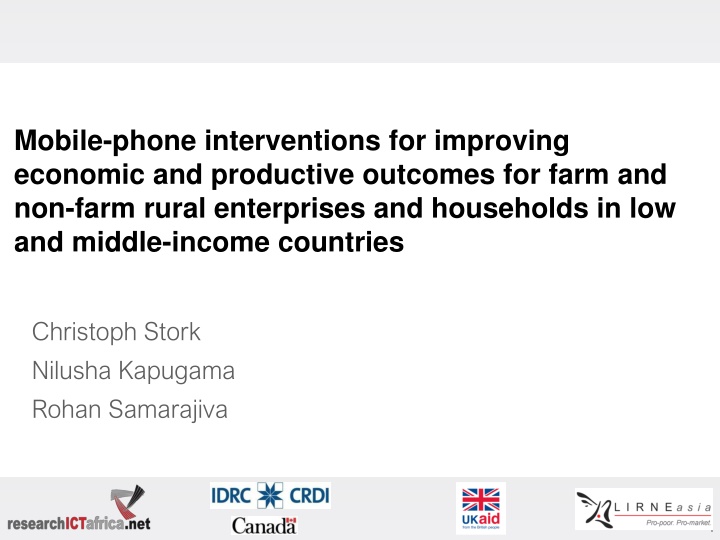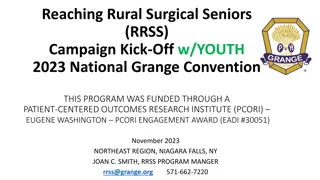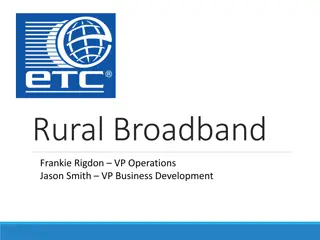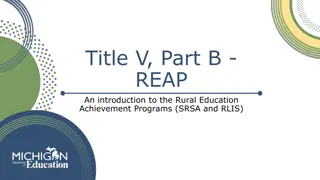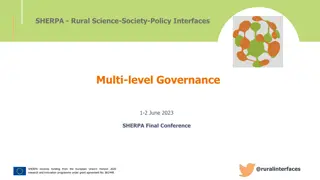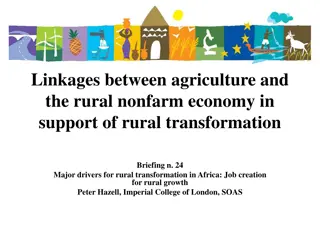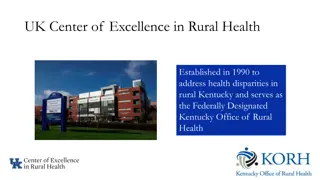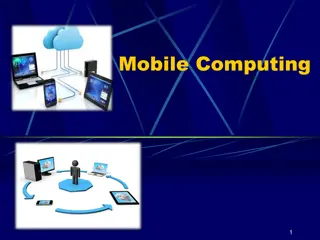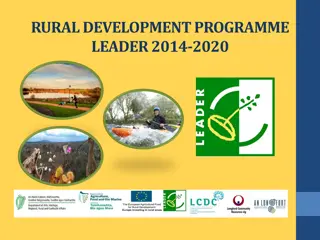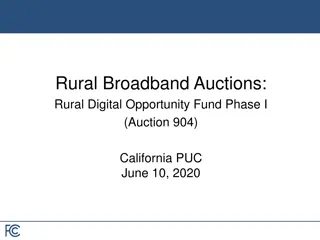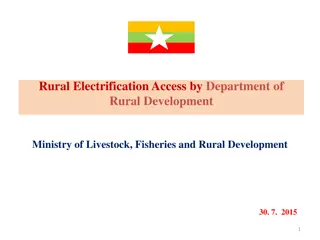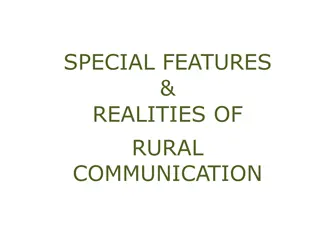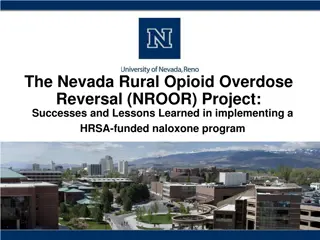Mobile Phone Interventions for Economic and Productive Outcomes in Rural Low- and Middle-Income Countries
This systematic review explores the impact of mobile phone interventions on economic and productive outcomes for rural enterprises and households in low- and middle-income countries. It includes evidence from natural experiments, addressing endogeneity and causality through instrumental variables or fixed/random effect models.
Download Presentation

Please find below an Image/Link to download the presentation.
The content on the website is provided AS IS for your information and personal use only. It may not be sold, licensed, or shared on other websites without obtaining consent from the author.If you encounter any issues during the download, it is possible that the publisher has removed the file from their server.
You are allowed to download the files provided on this website for personal or commercial use, subject to the condition that they are used lawfully. All files are the property of their respective owners.
The content on the website is provided AS IS for your information and personal use only. It may not be sold, licensed, or shared on other websites without obtaining consent from the author.
E N D
Presentation Transcript
Mobile-phone interventions for improving economic and productive outcomes for farm and non-farm rural enterprises and households in low and middle-income countries Christoph Stork Nilusha Kapugama Rohan Samarajiva 1
Systematic review Transparent and replicable review of literature on a precisely defined research topic Search protocols are specified Exclusion and inclusion criteria defined Initial selection based on title and abstract Next level selection based on full papers Data for included papers is extracted and synthesized 2
Intervention 1: Mobile Coverage Author Dependent variable Type of Study Max-Min spread of fish prices between market Coefficient of variation of price spread of fish Fish waste reduction Additional likelihood of a person being employed one year after coverage Banana and maize market participation Proportion of production sold Relative price of bananas and maize Price dispersion for millet: absolute value of the price differences between market pairs for each month Price dispersion for cowpea measured as absolute value of the differences between in logs of producer prices of two markets Price dispersion for cowpea measured as difference in Max- Min spread of prices between two markets Price dispersion for cowpea measured as difference in coefficient of variation between two markets Effect sizes for 6 years of coverage compared to no assets (log) Jensen (2007) Natural Experiment Klonner & Nolen (2008) Natural Experiment Megumi (2009) Natural Experiment Aker (2010) Natural Experiment Aker & Fafchamps (2011) Natural Experiment wage income (log) expenditure (log) Beuermann, et al. (2012) Natural Experiment 4
Mobile Coverage Evidence All natural experiments (coverage provision not under control of researcher) Endogeneity / Causality addressed by instrumental variables or fixed/random effect models Dependent variable across included studies differed even when measuring the same product 5
Jensen (2007) Jensen (2007) documents the impact of mobile coverage introduced between 1997 and 2001 in Northern Kerala, India, on price dispersion and waste in the fishing industry Fishermen were able to choose the market to sell to on the way back to shore by asking for current prices from multiple harbors or even agree on a sale Price dispersion in terms of minimum-maximum spread between markets in the same region dropped by 38% Waste, unsold fish, was reduced by 4.8% 6
Effect sizes of other coverage studies Klonner & Nolen (2008): if a municipality goes from 0% to 100% coverage employment increases by 33.7% the following year Megumi (2009): Coverage leads higher market participation of farmers that produce perishable crops Aker (2010): Coverage leads to a price dispersion reduction of 10-16% for millet markets in Niger Aker & Fafchamps (2011): Coverage reduced price dispersion for cowpeas by 6.3% in Niger Beuermann, et al. (2012): Coverage leads to increase in wage income of 15% after two years of coverage and 34 % after six years of coverage Coverage leads to value of household assets increased by 23% after two years and 54% after six years of coverage 7
Intervention 2: Mobile Phone Ownership Author Dependent variable Per capita monthly consumption Type of Study Observational Labonne & Chase (2009) Lee & Bellemare (2012) study Observational Price for onions in philipines study Dichotomous variable: Selling at the farmgate (0) or at the market (1) Choosing the marketplace: community (C), district (D), or regional market (R) Zanello, et al. (2012) Observational study 8
Mobile Ownership Evidence Labonne and Chase (2009): Mobile phone adoption leads to an 11-17% higher growth rate of per-capita consumption This was the only study that produced reliable results for the treatment category mobile phone The findings cannot be generalized due to small sample size and absence of representative sampling Lee and Bellemare (2012) Zanello, et al. (2012) 9
Intervention 3: Mobile Apps & Services Treatment Author Dependent variable Higher sale price Farmers revenues Household expenditures Crop loss Price dispersion Price received by farmers Crop loss due to rainstorms Type of Study Price and weather information using text messages (Colombia) Camacho & Conover (2011) Experiment - RCT Free one- year subscription to the Reuters Market Light service, market and weather information delivered SM (India) Ban on bulk SMS for 12 days (India) Having made use of ICT assisted agricultural extension services (India) Fafchamps & Minten (2011) Experiment - RCT Likelihood of changing crop varieties and cultivation practices Natural Experiment Parker et al. (2012) Standard deviation of geographic price dispersion for crops for each state Fu and Akter (2012)Quality Index (QI) Observational study 10
Reuters Market Light (RML) data for India Parker et al. (2012) Natural experiment Analyse the impact of access to information on geographic price dispersion in rural India using, an SMS based information service During the period of investigation bulk text messages were banned unexpectedly for 12 days across India allowing to identify the difference information availability on crop prices The average spatial price dispersion for 170 crops across 13 states increased by 5.2% during the time of the ban Fafchamps and Minten (2011): RCT Do not find significant differences between control and treatment group 11
Conclusion Mobile coverage enhances economic activities, leads to more price transparency and more efficient markets and benefits businesses, households and individuals. Mobile phones: The impacts of mobile coverage are linked to mobile phone ownership Only the study by Labonne and Chase (2009) provides credible quantitative results for the impact of mobile adoption Enough qualitative research that is not part of this review supports impact but does not quantify it Mobile apps and services: Not having found significant differences between control and treatment groups does not mean that there are no benefits It just means that is difficult to demonstrate impacts empirically or that not sufficient research has been conducted in this field Success of quantitative assessment of apps and services also depend on content quality, which cannot be assessed by reading studies 12
